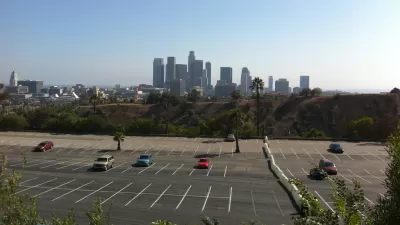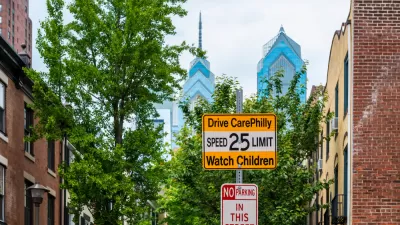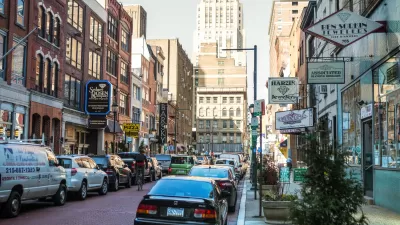Philadelphia's Mayor Michael Nutter has set a policy goal of becoming the "Greenest City in America," but the city's lack of progress in reducing automobile use is a troubling obstacle to such a lofty goal.
"In rather striking contrast with Pittsburgh and other big U.S. cities that have finally begun facing up to the role their auto-oriented planning and policy choices play in the climate challenge, Nutter’s Philadelphia is noteworthy for how little reckoning has taken place, particularly on City Council, and how ineffective policy “carrots” alone are at reducing car use," argues Jonathan Geeting.
Geeting cites a chart meant to tout the success of Philadelphia in reducing driving but finds only greenwashing.
Meanwhile, says Geeting, other cities are doing a much better job: "Over on the other side of Pennsylvania, Pittsburgh has been a national leader in cutting VMT while enjoying a substantially stronger economic recovery than Philadelphia and most of the nation, and Vancouver has overseen traffic declines of 20 percent on its major streets, even as its population has grown 4.5 percent since 2006…The difference is policy… city policy has largely avoided sticks to discourage driving."
Moreover, "[the] Nutter administration’s gains on bike-ped infrastructure are significant compared to the pre-Nutter status quo, and the increases in biking and walking shouldn’t be diminished. But there’s no getting around it: The impact has been weak in the face of Philadelphia’s impressive universe of car subsidies."
The post goes on to detail some of the possibilities for new parking policies and the politics preventing them from moving forward.
FULL STORY: There’s a Car-Sized Hole in Philly’s “Greenest City in America” Plan

Planetizen Federal Action Tracker
A weekly monitor of how Trump’s orders and actions are impacting planners and planning in America.

Chicago’s Ghost Rails
Just beneath the surface of the modern city lie the remnants of its expansive early 20th-century streetcar system.

San Antonio and Austin are Fusing Into one Massive Megaregion
The region spanning the two central Texas cities is growing fast, posing challenges for local infrastructure and water supplies.

Since Zion's Shuttles Went Electric “The Smog is Gone”
Visitors to Zion National Park can enjoy the canyon via the nation’s first fully electric park shuttle system.

Trump Distributing DOT Safety Funds at 1/10 Rate of Biden
Funds for Safe Streets and other transportation safety and equity programs are being held up by administrative reviews and conflicts with the Trump administration’s priorities.

German Cities Subsidize Taxis for Women Amid Wave of Violence
Free or low-cost taxi rides can help women navigate cities more safely, but critics say the programs don't address the root causes of violence against women.
Urban Design for Planners 1: Software Tools
This six-course series explores essential urban design concepts using open source software and equips planners with the tools they need to participate fully in the urban design process.
Planning for Universal Design
Learn the tools for implementing Universal Design in planning regulations.
planning NEXT
Appalachian Highlands Housing Partners
Mpact (founded as Rail~Volution)
City of Camden Redevelopment Agency
City of Astoria
City of Portland
City of Laramie





























